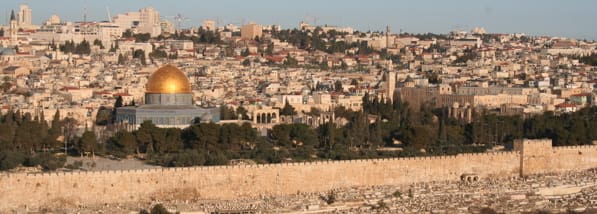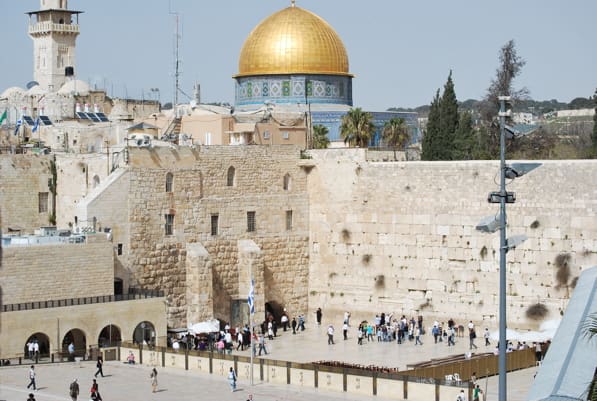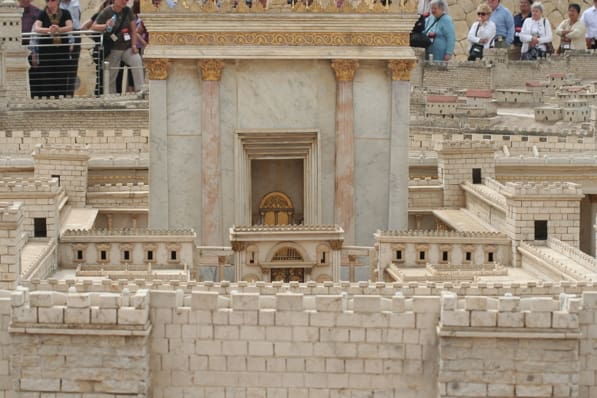 With the debut of The Faithful Traveler in the Holy Land on EWTN this month (see details below), I am exploring the sites in the Holy Land. This month, in honor of the Feast of the Presentation of the Lord, we’ll be looking at the history of Jerusalem’s temple and what remains of it today.
With the debut of The Faithful Traveler in the Holy Land on EWTN this month (see details below), I am exploring the sites in the Holy Land. This month, in honor of the Feast of the Presentation of the Lord, we’ll be looking at the history of Jerusalem’s temple and what remains of it today.
Forty days after Jesus was born, the Holy Family travelled to Jerusalem, where they presented the baby to the Lord in the Temple. But did you know that that temple was actually the second temple of the Jews in Jerusalem? The history of the Jewish temple in Jerusalem is long, complicated, and a little confusing. But I’m going to try to unpack it all here.
Remember when the Jews were wandering the desert with Moses, carrying around the Ark of the Covenant, which held the tablets on which were written the Ten Commandments? The Jews believed that the tabernacle held God’s divine presence here on earth, and so they sought to build it, and thereby God, a permanent home. According to Jewish history, it wasn’t until more than 400 years passed that King David made it his mission to built this home for God. God had other plans, and while David bought the land on which this temple would be built, it was his son, Solomon, who actually had the temple built around 832 BC.
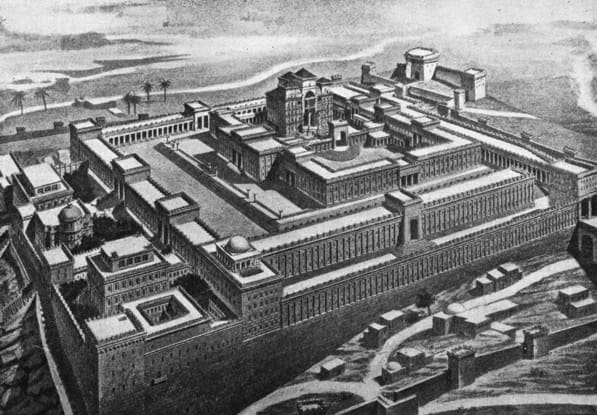 Solomon’s temple is said to have been about 1000 x 1000 feet (500 x 500 cubits), and it was–and some say still is–the focal point of the city of Jerusalem as well as that of the soul of every Jew. The temple housed the tabernacle within the highest place in the temple, the Holy of Holies, which was 44 feet higher than the base of the temple and rose to a height of 240 feet (about as high as a 20-story building). The Holy of Holies was built atop the Foundation Stone, believed by Jews to be the place from which God created Adam, where Noah gave thanks to God after the flood waters receded, and where Abraham almost sacrificed his son, Isaac. The Ark of the Covenant was placed atop this stone. The room was so holy, no one ever entered it except for one man–the High Priest of Israel–and that was only once a year, on Yom Kippur, the Jewish Day of Atonement. Solomon’s temple was destroyed in 586 BC by invading Babylonians, but the Jews believe that the Ark of the Covenant was hidden some thirty years before, after a prophet learned of the future destruction of the temple.
Solomon’s temple is said to have been about 1000 x 1000 feet (500 x 500 cubits), and it was–and some say still is–the focal point of the city of Jerusalem as well as that of the soul of every Jew. The temple housed the tabernacle within the highest place in the temple, the Holy of Holies, which was 44 feet higher than the base of the temple and rose to a height of 240 feet (about as high as a 20-story building). The Holy of Holies was built atop the Foundation Stone, believed by Jews to be the place from which God created Adam, where Noah gave thanks to God after the flood waters receded, and where Abraham almost sacrificed his son, Isaac. The Ark of the Covenant was placed atop this stone. The room was so holy, no one ever entered it except for one man–the High Priest of Israel–and that was only once a year, on Yom Kippur, the Jewish Day of Atonement. Solomon’s temple was destroyed in 586 BC by invading Babylonians, but the Jews believe that the Ark of the Covenant was hidden some thirty years before, after a prophet learned of the future destruction of the temple.
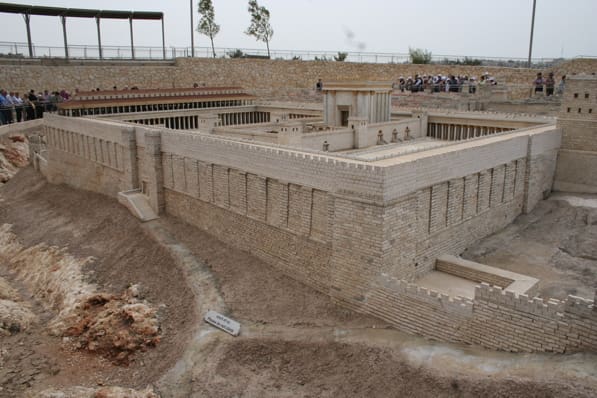 Around 515 BC, the Jewish leader Zerubbabel rebuilt the
Around 515 BC, the Jewish leader Zerubbabel rebuilt the 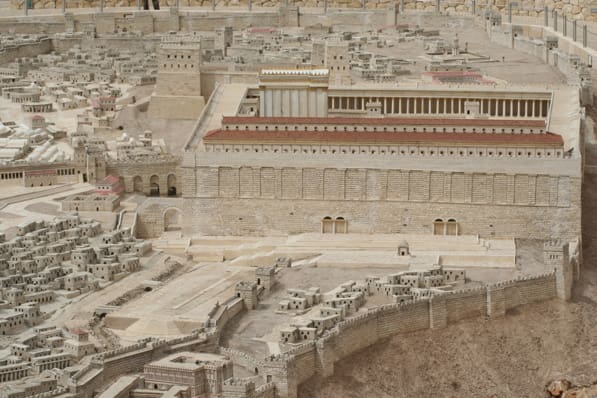 Temple. Centuries later, in an attempt to atone for his sins, Herod the Great expanded the temple and made it a thing of wonder. It was this temple in which the baby Jesus was presented, where Mary and Joseph found him a few years later, after a pilgrimage to the city, and from which he later
Temple. Centuries later, in an attempt to atone for his sins, Herod the Great expanded the temple and made it a thing of wonder. It was this temple in which the baby Jesus was presented, where Mary and Joseph found him a few years later, after a pilgrimage to the city, and from which he later  expelled the money changers. That temple stood until 70 AD, when the city of Jerusalem was destroyed by the Romans.
expelled the money changers. That temple stood until 70 AD, when the city of Jerusalem was destroyed by the Romans.
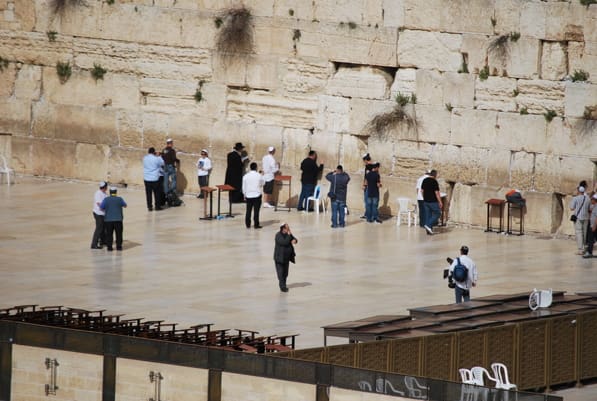 Today, the only thing that remains of the temple is a wall that retained the mountain on which the temple was built, called Temple Mount. The wall is known as the Western Wall, or Kotel by Jews, and it has been a site of Jewish prayer and pilgrimage since the destruction of the Second Temple. Jews believe that because this wall was built through funds donated by the poor, God decreed that His Divine Presence would never leave the Western Wall.
Today, the only thing that remains of the temple is a wall that retained the mountain on which the temple was built, called Temple Mount. The wall is known as the Western Wall, or Kotel by Jews, and it has been a site of Jewish prayer and pilgrimage since the destruction of the Second Temple. Jews believe that because this wall was built through funds donated by the poor, God decreed that His Divine Presence would never leave the Western Wall.
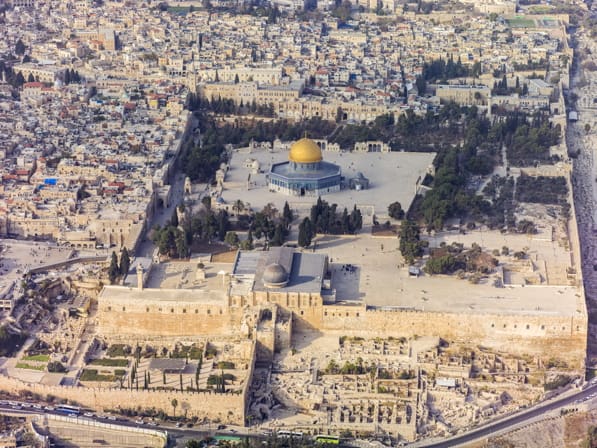
One of the Holy Land’s most iconic buildings sits atop Temple Mount: the Dome of the Rock. Built in 691 AD, the Dome of the Rock is Islam’s third holiest site. Muslims believe that the stone called the Foundation Stone by the Jews is the same stone from which Muhammad ascended into Heaven accompanied by the Angel Gabriel.
Today, pilgrims to Jerusalem can see an amazing model of the Second Temple, and the entire city of Jerusalem as it was during Jesus’ life at the Israel Museum. It is intricate in design, and gives you a wonderful opportunity to see Jerusalem as Jesus saw it.
Please tune in to EWTN’s debut of The Faithful Traveler in the Holy Land, February 17-22nd at 6:30 pm/3 am Eastern. Watch David and Diana von Glahn live on EWTN’s show, Life on the Rock on February 13th at 10 pm, with reruns on February 14th at 8 PM, February 15th at 1 AM, and February 18th at 9 AM (all times Eastern). Check EWTN’s channel finder to find out where EWTN airs where you are, or watch it live online. Check their schedules for future broadcasts.
Photography: Courtesy of Diana von Glahn, used with permission.
Other art credits: Ideal reconstruction of the Temple of Solomon in Jerusalem according to the description from the Bible (not a reconstruction based on archaeological grounds), copyright expired, PD; Southern aerial view of the Temple Mount (in the Old City of Jerusalem): Annotated in the foreground is Al-Aqsa Mosque considered to be the third holiest site in Islam after Mecca and Medina. Behind are The Dome of the Rock and to the right, The Dome of the Chain and served as a model for the building of the Dome of the Rock (c. 691 AD), 15 November 2013, Godot13 own work with photo credit to Andrew Shiva, CC; both Wikimedia Commons.



